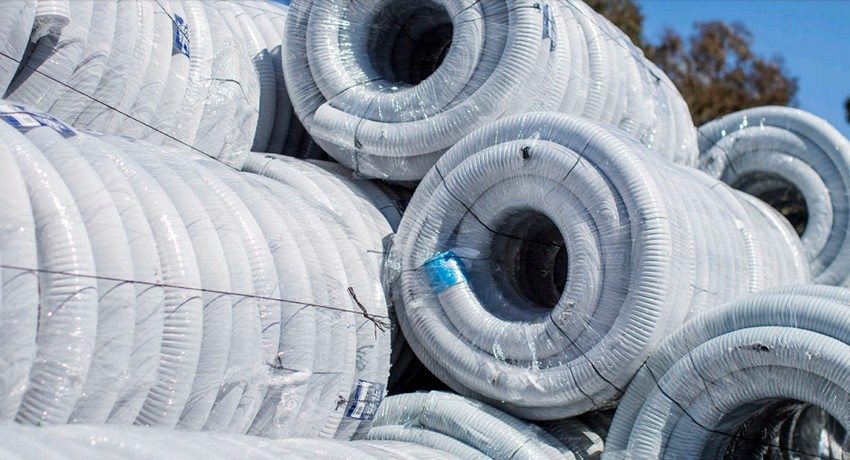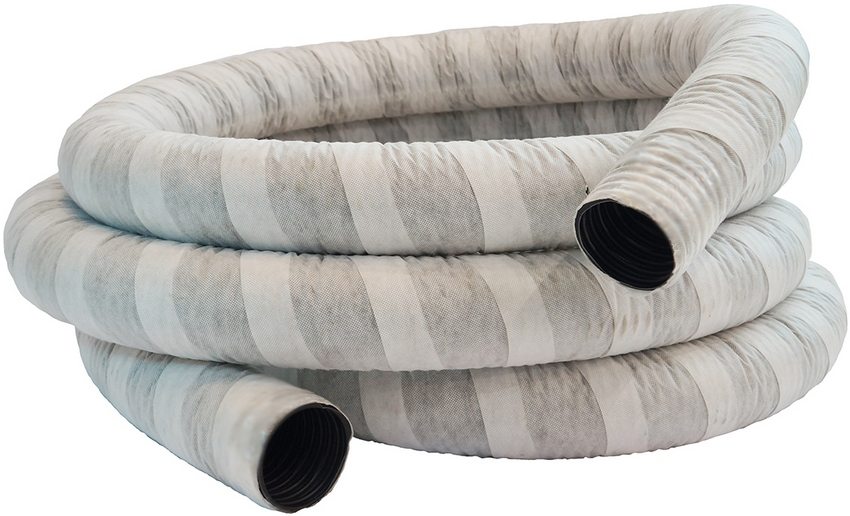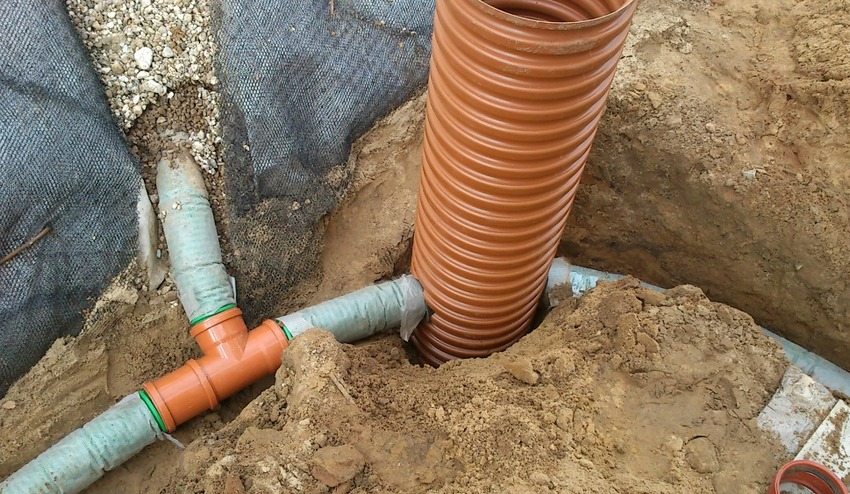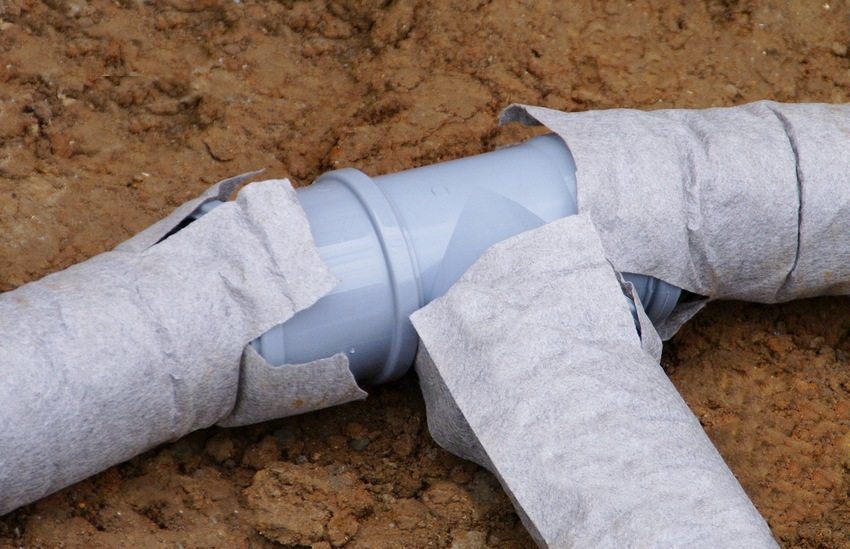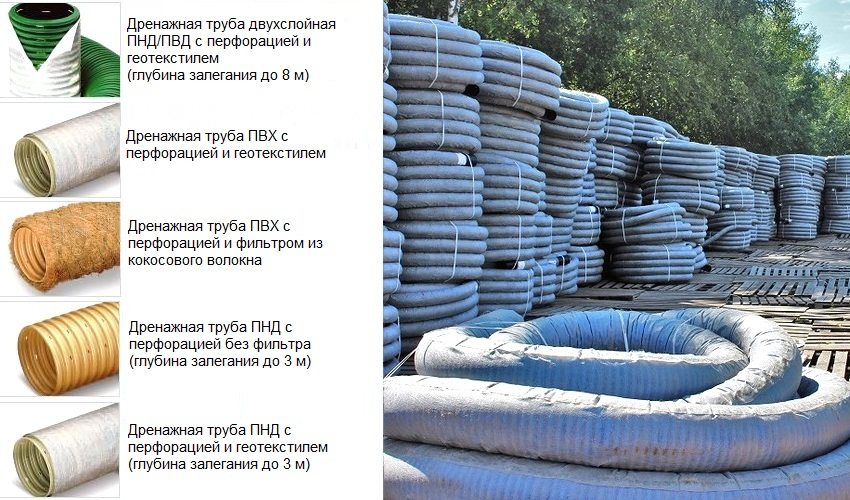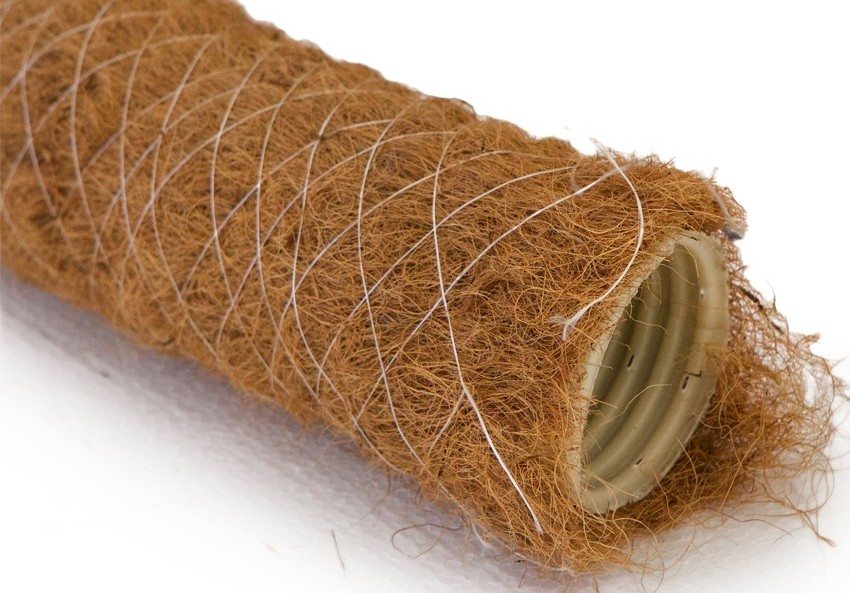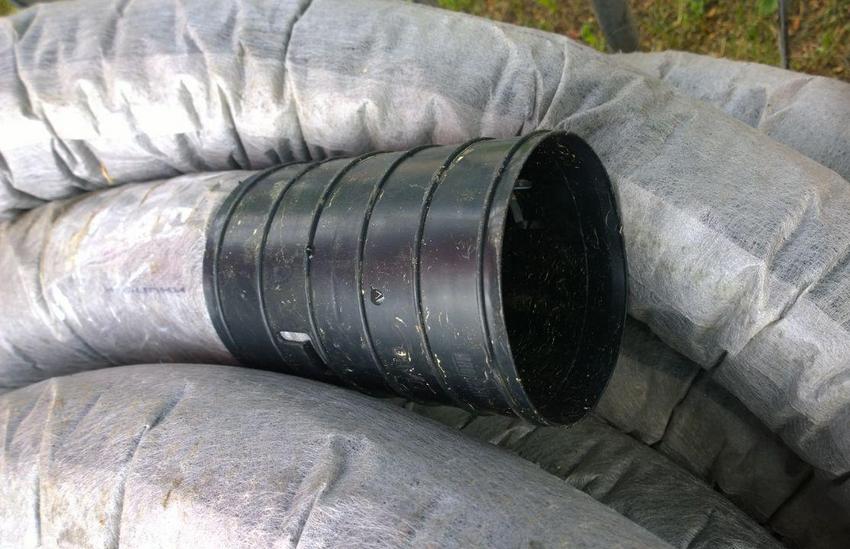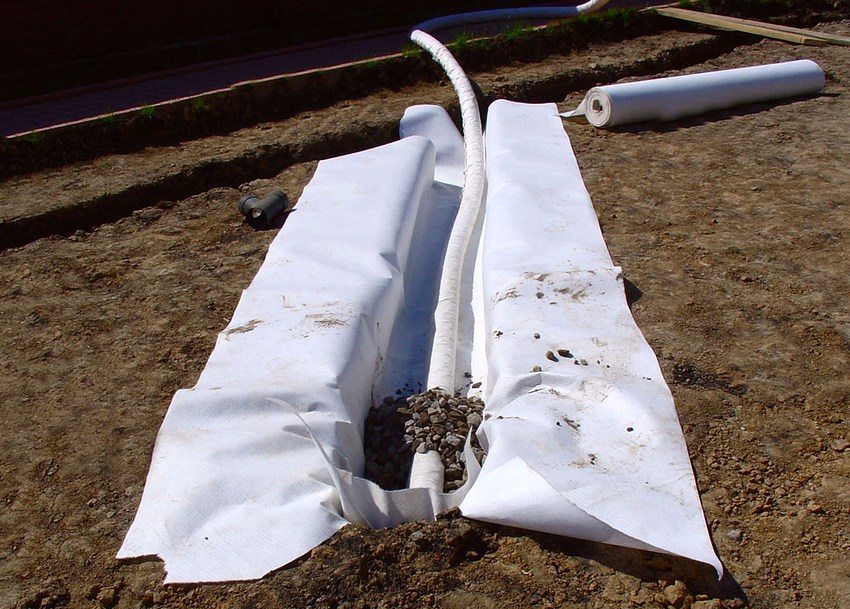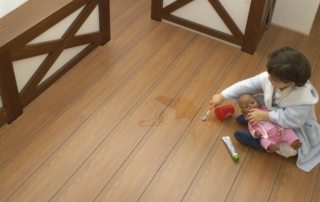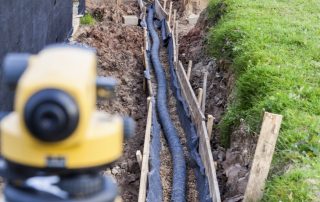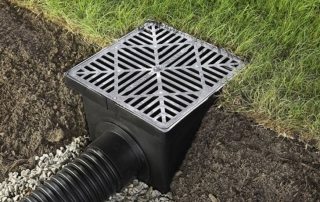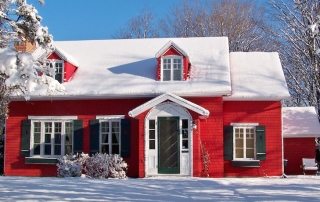The article will consider the question of what is better to use as a filtering cloth, which will be required if drainage pipe 110 in a filter is used for arranging storm sewers: geotextile or coconut fiber. The main types of pipes used for the organization of the drainage system, the features of their selection and use in a suburban area, as well as the prices for the purchase of consumables for construction will be considered.
Content
Types of drainage pipes for groundwater disposal: price and classification
Any suburban area, regardless of whether it will be used for growing vegetables or purchased for building for a residential building, needs a drainage system. This system is an extensive pipeline laid under the surface of the soil and performing the function of outgoing communications that transport storm water outside the site.
The elements of such ejection systems are primarily classified according to the type of material. The modern range of pipes is divided into groups, including products based on:
- polymers;
- ceramics (pipes with a perforated surface);
- asbestos cement.
Note! The use of drainage and stormwater pipes is a must if you want to preserve the foundation of your home. Often storm water heats the cellars with conservation, basements and the base of a residential building, provoking the development of dampness and fungus, the formation of cracks and other damage.
The price of pipes for storm sewers depends on the material of manufacture, diameter, length and other parameters. Asbestos-cement and ceramic products are practically not used today due to the large number of disadvantages compared to their plastic counterparts.
Average prices for asbestos-cement pipes:
| Diameter, mm | Pipe length, mm | Weight, kg | Price, rub / piece |
| 100 | 3950 | 17,7 | 330 |
| 150 | 34 | 539 | |
| 200 | 64,2 | 1035 | |
| 200 | 5000 | 70 | 1290 |
| 250 | 93,1 | 1945 | |
| 300 | 143,1 | 2570 |
The main disadvantage of asbestos-cement pipes, in addition to low performance, is their heavy weight. Compare the data in this table with the retail prices of plastic drainage pipes 110 mm or more to get a feel for the difference between these materials.
Drain pipe 110 in filter: geotextile and coconut fiber
Despite the wide choice of sizes, it is the drainage pipes 110 in the filter that are most often used when laying the storm sewer and drainage system. The filter material increases the efficiency of the entire system.
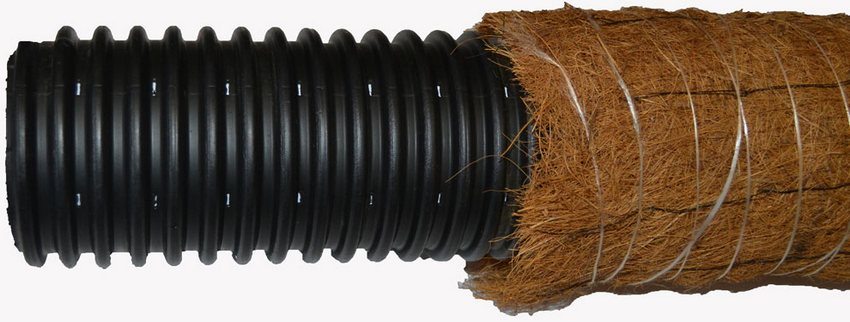
Drainage pipe perforated and coconut filter
The use of drain pipes 110 with a geotextile filter or other filter media option can trap coarse debris, grains of sand, and fine dirt particles. By purchasing such products for organizing a drainage system, you will significantly reduce the rate of internal siltation and increase the service life of the pipeline.
For wrapping pipes, special webs are usually used, which are a non-woven material with hygroscopic properties. The canvases are divided into groups according to the type of material, which can be natural or artificial.
Note! Filter efficiency is based on its bandwidth, measured in microns. According to this indicator, it is possible to calculate the size of particles that the filter is capable of retaining: 1 micron = 0.0001 cm. The straw filter has the highest throughput - 12000 microns, polyester has the lowest - 180-240 microns.
The most popular among consumers are drainage pipes in geotextiles and coconut fiber. Geotextile while as a filtering material it has a throughput in the range of 450-700 microns. It is most often used on clay and sandy soils. Due to its excellent operational properties, this type of coating on pipes does not decompose.
Related article:
Concrete and plastic drainage well for storm sewers. Types and features of structures. Rules for arranging wells and a detailed description of this process. Calculation of storm sewers.
Products wrapped in coconut fiber have an inherent permeability factor of 700 microns. Such a pipeline is usually laid in sandy, agricultural types of soil, as well as peat. Unlike the previous version, the material is degradable.
Coconut fiber and geotextile: prices of drainage pipes in a 110 mm filter
Geotextile is a non-woven, and in rare cases woven fabric, made on the basis of polyester or polypropylene threads. There are product options where both types of these threads are used.
Geotextiles are widely used in medicine and the production of home furniture, but this type of material is most widely used in construction. Many drainage pipe manufacturers have already appreciated the benefits of geotextiles, so most of them are gradually phasing out the use of coir and other filters.
Helpful advice! The low price of a drainage pipe 110 per running meter is one of the significant advantages of products wrapped in geotextiles. Take advantage of this advantageous property to save your drainage construction costs.
Prices for drainage pipes with geotextile and coconut fiber (comparison table):
| Filter type | Pipe diameter, mm | Coil weight 50 m, kg | Volume, m³ | Price, rub / lin. m |
| Geotextile | 63 | 13,55 | 0,49 | 47 |
| 90 | 20,4 | 0,96 | 60 | |
| 110 | 24,3 | 1,41 | 75 | |
| Coconut fiber | 63 | 12 | 0,7 | 172 |
| 90 | 17,5 | 1 | 235 | |
| 110 | 28 | 1,75 | 276 |
According to this table, the cost of drainage pipes 110 mm in geotextile is three times less than that of similar products in coconut fiber. The same trend is observed for pipes with a different diameter when comparing these filter media.
Advantages of storm sewer pipes in geotextile: material properties
The price of a drainage pipe 110 mm in a geotextile filter is not the only advantage of the products. This version of the material has other advantages:
- high vapor permeability, contributing to the uniform distribution of air and preventing the development of harmful microorganisms;
- resistance to rolling, damage or flaking;
- increased resistance to high temperatures;
- low flammability index;
- invulnerability to the effects of insects and other living organisms whose habitat is soil;
- the ability to effectively perform their functions over a long period;
- durability.
Note! If you decide to buy drainage pipes for groundwater drainage with a geotextile filter, in the absence of significant loads, this material can last almost as long as the entire installed system.
What else can you buy pipes for storm sewers with geotextiles
Geotextile goes well with any type of drainage pipe. But in combination with polymer products, it is able to bring the maximum number of benefits.
Polymer communications can be made from various raw materials:
- polypropylene;
- polyvinyl chloride (pipes marked with PVC);
- polyethylene (pipes marked with HDPE and LDPE).
There are also smooth, perforated and corrugated pipes on sale. At the same time, depending on the design features, two-layer and single-layer drainage pipes are distinguished.
Prices for two-layer products with perforation:
| Pipe type | Product diameter, mm | Bay, m | Coil weight, kg | Volume, m³ | Price, rub / lin. m |
| Double layer | 90 | 50 | 20,4 | 0,9 | 135 |
| 110 | 24,3 | 1,4 | 150 | ||
| 160 | 42,9 | 2,9 | 215 | ||
| 200 | 40 | 44,8 | 3,2 | 325 |
Features of drainage corrugated pipes in the filter geotextile 110 mm
Corrugated products have an uneven ribbed surface. Such pipes are produced with special holes that serve as a filter. They are great for organizing drainage systems and storm sewers located below the soil surface.
Helpful advice! Use the properties of corrugated products to form complex pipelines with turns. Thanks to their flexible structure, these pipes eliminate the need for fittings when installing the system. In addition, they provide a high-quality and easy connection to wells.
Most corrugated products are manufactured using PVC or low pressure polyethylene. They have special markings that allow you to quickly navigate the range.
For example, the marking on the drain pipe in the filter "DGT PND d110" means the following:
- DGT - drainage corrugated pipe;
- HDPE - low pressure polyethylene;
- d110 - product diameter in mm.
If you intend to buy a drainage pipe for your construction, corrugated products can be either with or without a filter. In the first case, the average cost of a product is 71 rubles / running meter, in the second - 67 rubles / running meter.
Drainage pipes in geotextiles: how to lay the pipeline according to the rules
Compliance with all the rules of the pipeline laying technology presupposes the correct choice of materials. If you make a mistake at the initial stage, the work will have to be redone.
Before you buy pipes for the drainage ditch and other elements of the system, preliminary calculations should be made. The indicator of rigidity and flexibility plays an important role. Experts recommend purchasing rigid pipes for organizing surface piping, while for installing a buried system, it is better to take flexible product options.
Rigid pipes are characterized by high ring stiffness. It indicates the degree of deformation of the product, which can occur in the event of strong mechanical stress.
Note! Non-flexible pipes have dimensions in the range of 6-12 m. While flexible versions of products can have a length of about 40-50 m.
Ring stiffness (decoding of markings on pipes):
| Numerical value, SN | Maximum burial length, m |
| 2 | 2 |
| 4 | 3 |
| 6 | 4 |
| 8 | 10 |
| 16 | more than 10 |
Rigid pipes retain their strength even in the event of soil displacement. The disadvantages of such designs include the costs associated with the need to purchase additional nodal parts for organizing pipeline turns. These include tees for a drain pipe 110 mm, bends, couplings. Manufacturers offer nodal parts suitable for the main product diameters: 110, 160, 200, 250 and 315 mm.
Features of laying drainage pipes with geotextiles
During the transportation of pipes, care should be taken, as well as during their installation. If for some reason the material gets even a single damage, in the future this section of the pipe will be subject to constant clogging, and the drainage procedure will be disrupted and become uneven.
Many manufacturers produce geotextile-coated pipes. This greatly facilitates the installation process. The technology for installing the system also assumes the self-wrapping of products with a cloth, which can be purchased separately.
Not all types of geotextiles on sale can pass water, therefore not every type of material is suitable for laying drainage pipes with your own hands. A suitable option is polypropylene webs obtained by a needle-punched method and consisting exclusively of monofilaments.
Rules for handling geotextiles:
- it is better to unpack geotextile at the very last moment, since exposure to ultraviolet radiation reduces the performance of the material. For the same reason, it is recommended that all work with the canvas be done very quickly;
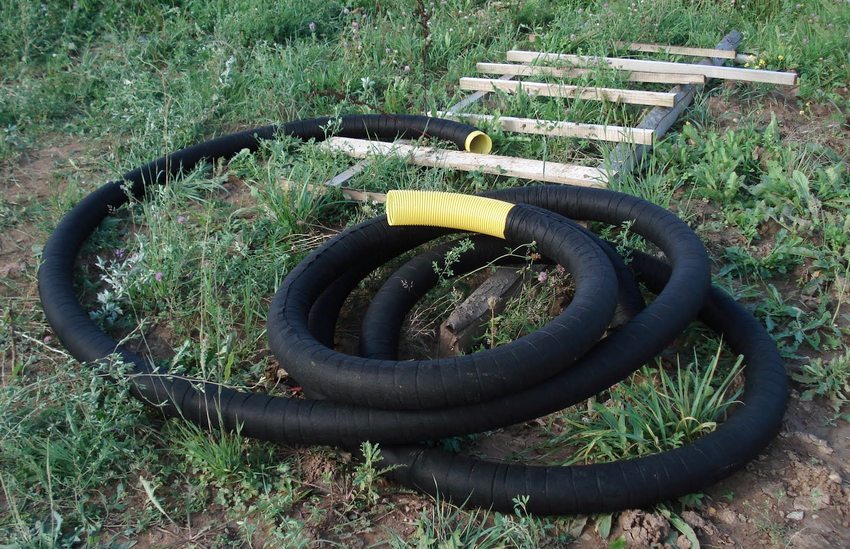
Plastic drainage pipes have a long service life and are resistant to various negative environmental influences
- the trench must be prepared in advance, cleaned, and have smooth edges. Thanks to this, you will eliminate any possibility of damage to the geotextile during the laying of the pipeline;
- the material fits as freely as possible, but at the same time there should be no waves and folds on its surface;
- geotextiles should be pre-cut into sheets of a suitable size. They should overlap the filtering layer around the pipe (0.3-0.6 m);
- the material must be immediately covered with gravel. In order not to damage the geofabric during the compaction of the embankment, the layer thickness should be at least 0.25-0.3 m.
When the canvas is rolled up, its edges are fixed by refilling the ditch with sand or soil. Otherwise, the technology of working with the canvas does not differ from the usual installation of a storm system with already wrapped pipes.
